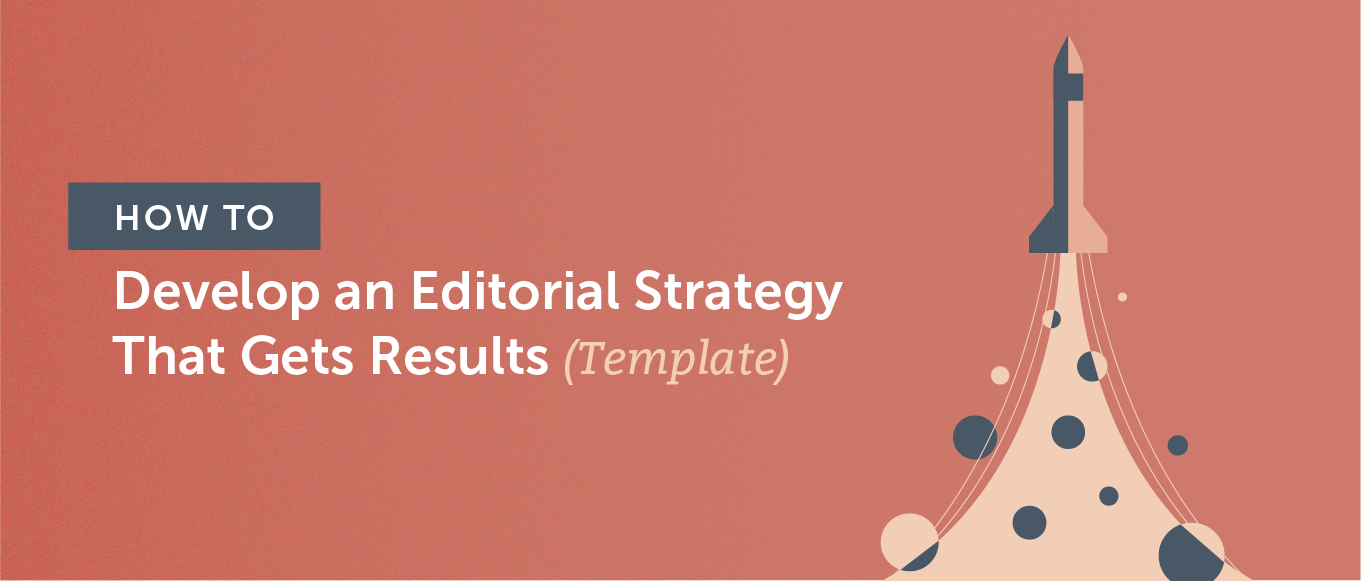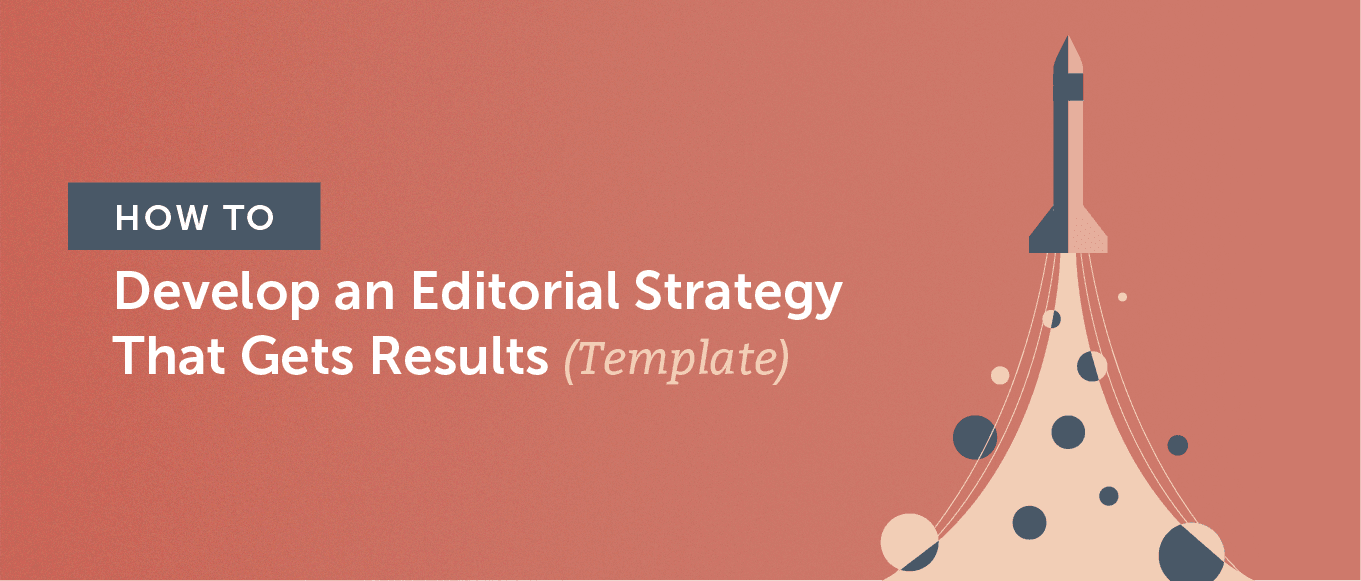
If you’re an ambitious marketer with even more ambitious marketing goals, some of these may be true for you:
You have many ideas and not enough time to explore them all.
Your marketing projects fall behind; tasks slip through the cracks.
You have to press pause on promising projects because business priorities have changed.
You and your team are spread too thin.
How many of these are your pitfalls? One? Two? All of them?
You’re not alone. Although content marketing is quite magical, all of its possibilities make it easy to burn out trying to do it all and losing sight of goals and priorities.
This is where a solid editorial strategy can help. In this guide, you’ll easily develop one. You’ll learn:
How to focus on your most valuable audience, so you can help them hit their goals while you hit your own.
The tools and practices that will help you streamline content creation without sacrificing its quality or consistency.
An efficient strategy to turn a big-picture marketing overview into actionable tasks, so that no project ever falls behind.
You’ll go from overwhelmed to inspired, and you’ll enable your team to do the same. Hitting your marketing goals will no longer be a challenge.
[Cookie “Get Your Editorial Strategy Template || https://media.coschedule.com/uploads/2020/06/blog-develop-an-editorial-strategy-that-gets-results-07.png || Download Now || https://media.coschedule.com/uploads/2020/06/Editorial_strategy_template_docx_BVgXWiV5.docx.docx.zip”]
[Tweet “How to develop an editorial strategy that gets results (template)”]
What You Need to Know About Editorial Strategy
7 Simple Steps to Plan, Document, and Execute Your Editorial Strategy
Step 1: Identify Your Target Audience
Step 2: Establish Editorial Guidelines
Step 3: Draft a Simple Style Guide
Step 4: Choose Content Channels
Step 5: Set a Publishing Cadence
Step 6: Develop Workflows for Each Type of Content
Step 7: Visualize Your Publishing Schedule on an Editorial Calendar
Create Your High-performing Editorial Strategy
What You Need to Know About Editorial Strategy
What is an Editorial Strategy?
An editorial strategy outlines the content formats, channels, and workflows that drive your marketing efforts and enable you to hit your marketing goals.
It centers on your target audience at all times. Because of that, an editorial strategy sets firm standards and expectations of content based on what your audience wants.
Think of your editorial strategy as a central roadmap that maximizes your team’s efforts, so you can see the highest possible ROI and support your overall business goals. It’s a document that removes all the guesswork from your content creation — you and your team can always refer to it ahead of projects and planning sessions.
The Ultimate Benefits of Having an Editorial Strategy
In a nutshell, an editorial strategy will help you deliver:
The right content
To the right customers
At the right time
You’ll be able to do so consistently and generate more (and better) leads, close more deals, and drive a great return on your investment.
What does this look like in practice? How does an editorial strategy directly make this happen?
It helps you better understand what your audience wants. Ever heard of the concept of throwing spaghetti against the wall to see if anything sticks? Knowing what your audience wants helps you avoid this. Instead of trying everything under the sun, you’ll identify a message that works and double down on it. No effort wasted!
It lets you identify the best ways to deliver that message in your content. If you try to show up on every channel and in every format, you may feel burned out — especially if you have a smaller team. An editorial strategy will help you show up on the right channels and master the right content formats.
It gives you an easy-to-follow content creation plan and keeps you organized. Instead of delayed projects and tasks that slip through the cracks, you’ll have a foolproof set of workflows and checklists, so you can always deliver content that resonates with your audience.
In simple terms, your editorial strategy will help you create relevant and unique content that brings exceptional marketing outcomes.
Back to the Top
7 Simple Steps to Plan, Document, and Execute Your Editorial Strategy
Step 1: Identify Your Target Audience
Creating content for a broad, vague audience feels like talking into a megaphone and hoping that someone reacts to any of the things you’re saying.
[Tweet “Creating content for a broad, vague audience feels like talking into a megaphone and hoping that someone reacts to any of the things you’re saying.”]
For your target customer, this feels uninteresting, at best, and frustrating, at worst.
Consider the exact opposite.
Creating content for a well-defined target audience feels like addressing them by their first name. It shows you understand their goals, challenges, and pain points that stand in their way.
For your target customer, this feels like you’ve read their mind. You offered an answer to the exact question they had.
That’s the ultimate marketing win.
To define your target audience, answer these questions:
Who are our best customers?
Hint: Find your best customers by looking for those that have been with you the longest, spent the most money, seen the best results with your product, and/or recommended you to others.
What qualities do these customers share? Are there patterns in their behavior?
What made these customers search for a solution like the one we offer?
What is the outcome these customers want to achieve? Why have they chosen us instead of our competitors?
Two main ways you can answer these questions are:
Conducting customer surveys
Analyzing product usage (i.e. user activity, CRM data, customer support conversations, etc.)
Recommended Reading: The Complete Start to Finish Content Marketing Strategy Guide (Template)
To solidify your target audience definition, use a target audience statement.
{Insert your company} creates content to attract {insert target audience}, so they can {insert desired outcome} better.
For example, this is what the target audience statement may look like for CoSchedule:
CoSchedule creates content to attract professional marketing managers, so they can get organized better than ever.
Your target audience statement should drive all your content efforts and bring clarity to the process.
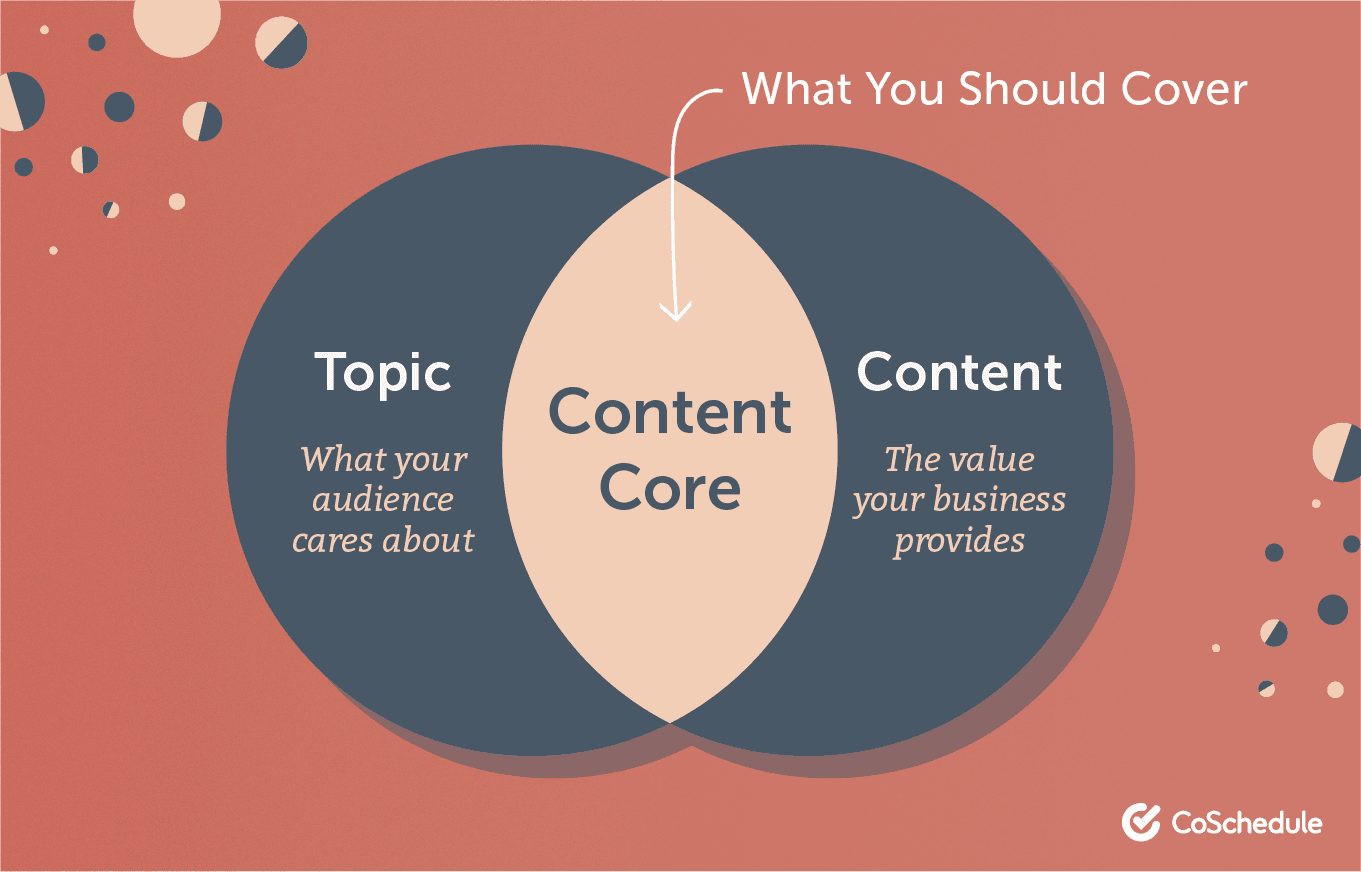
Back to the Top
Step 2: Establish Editorial Guidelines
The only way to deliver the best content every single time is by setting the bar high. This way, you’ll end up with a high-quality piece of content no matter if it’s you, your team, or guest writers creating it.
To do this, you need to create strong editorial guidelines. In CoSchedule, these are appropriately called standards of performance.
These are the core principles that all content must follow. It reflects the needs and wants of the target audience you’ve defined in the previous step. If the content doesn’t follow these principles, it won’t get published.
Here are CoSchedule’s standards of performance:
Comprehensiveness: Aiming to serve readers in a single click, so they don’t have to read multiple pieces to find the information they need.
Strategic keyword targeting: Covering topics rather than just single keyword terms.
Actionability: Showing readers how to implement our advice.
Relevancy: Choosing topics that are relevant to both the business and the readers.
By following these standards of performance, CoSchedule has carved out their own space in the world of marketing technology; they produce competition-free content.
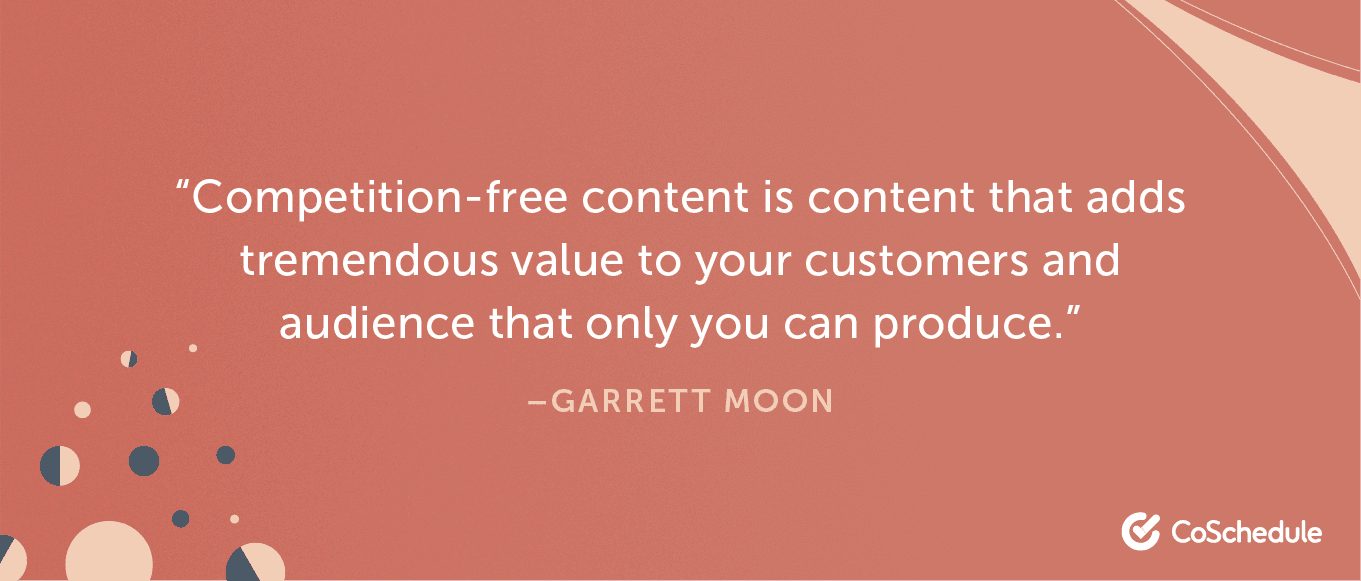
For you to achieve the same, think about what makes you unique and how you can use it to create what your competition isn’t creating.
Recommended Reading: How to Structure a Powerful Digital Marketing Strategy (Template)
Here’s a three-part framework that can help: look, research, and strategize.
Part 1: Look
Observe your competitors by surveying the landscape. You could answer these questions:
Are my competitors running TV, radio, and other traditional channel ads?
Are they active through Facebook ads, email marketing, and other digital platforms?
Do they have engaged audiences, and if so, on which channels?
Part 2: Research
Head to Google and search for terms related to your products and services. By looking at the top ten search results, look at what is consistent and what stands out. Answer these questions:
How long is my competitor’s content?
How many images do they use?
Do they use strong calls to action?
How strong are their customer testimonials?
Are their product sales attracting attention locally, regionally, and nationally?
Part 3: Strategize
This is the fun part. It’s where you’ll uncover how to make your content different and possible to execute well.
What are my team and I really good at?
What are our competitors doing that’s similar?
What’s in it for our customers?
Are there people in our customer base or audience our content underserves?
What have we already created that we’re most proud of?
This is the exact framework that led CoSchedule to above-listed standards of performance. Use these questions to define yours.
Back to the Top
Step 3: Draft a Simple Style Guide
Editorial guidelines are a big-picture overview of standards each piece of content needs to meet.
The next step is to create a style guide that will help you maintain consistent voice, style, tone, and formatting across the board. It’s the nitty-gritty part of content creation.
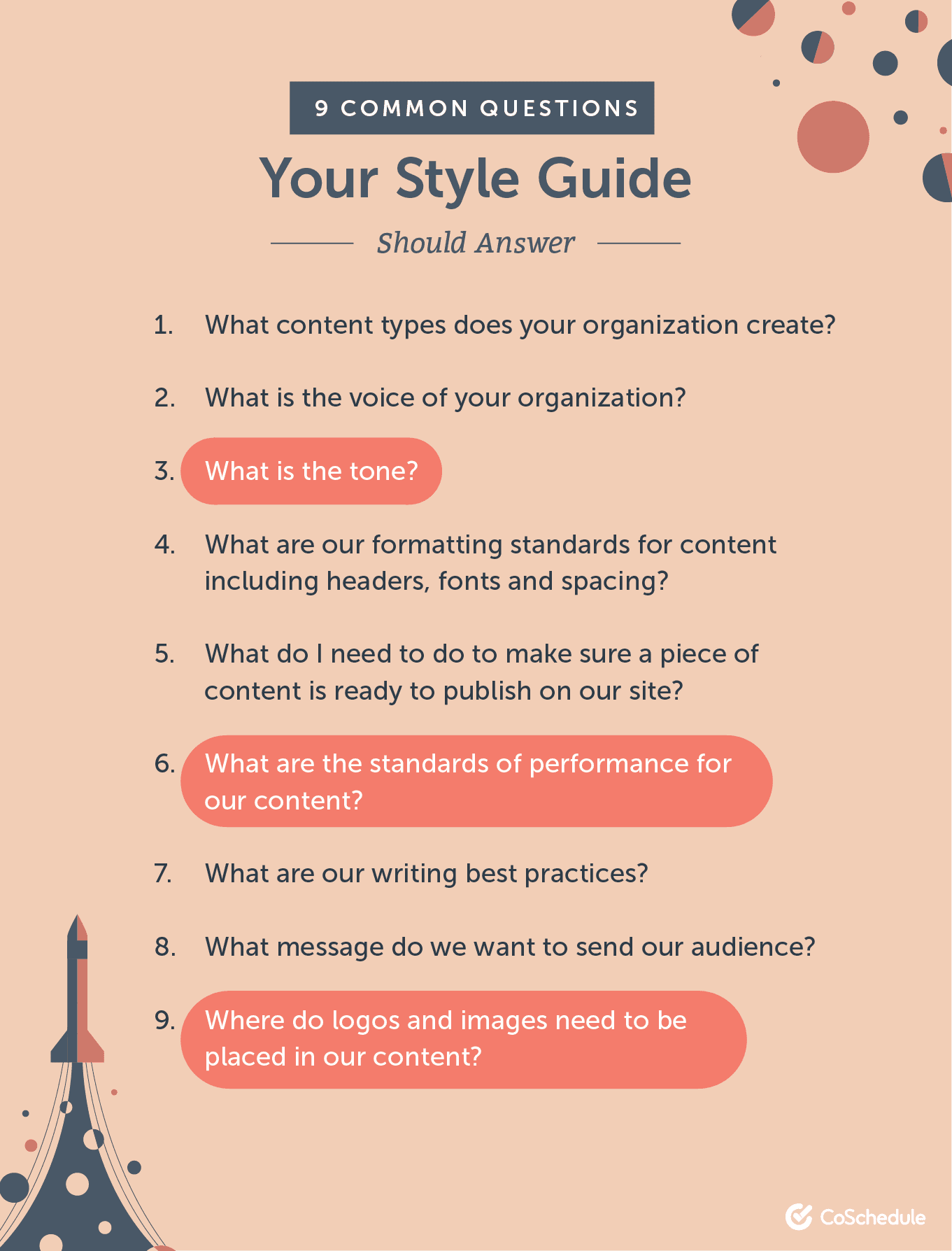
A style guide is a document that outlines expectations around grammar, spelling, design elements, and much more. As such, it can vary from a few simple pages to a long, detailed guidebook.
Recommended Reading: How to Plan an Internal Marketing Strategy That Makes an Impact
If you don’t have a style guide yet, here’s a simple list that will help you make it simple and super effective.
Tense: Past, present, or future tense. Choose one and add an example.
Voice: Most writing should be active voice. Is passive voice acceptable, and in which circumstances? If so, add an example.
Point of view: First person, second person, or third person. Choose one and add an example.
Internal jargon translations: Identify all jargon that comes up in your customer-facing content, list it, and add the customer-friendly version of that phrase.
Branded terms: List all company-specific product names and terms in correct spelling and formatting.
For example, CoSchedule is the only correct capitalization — never Coschedule.
Brand voice: Voice is your brand’s personality. Fill in the framework: “We are [insert desired perception], but we are not [insert antonym of desired perception].”
For example:
We are professional but not stuffy.
We are smart but not arrogant.
We are technology savvy but not inaccessible.
Tone of voice: Tone is the inflection of your brand voice and may change in various situations. Use these prompts:
If [situation one] occurs, use [adjective] tone.
If [situation two] occurs, use [adjective] tone.
If [situation three] occurs, use [adjective] tone.
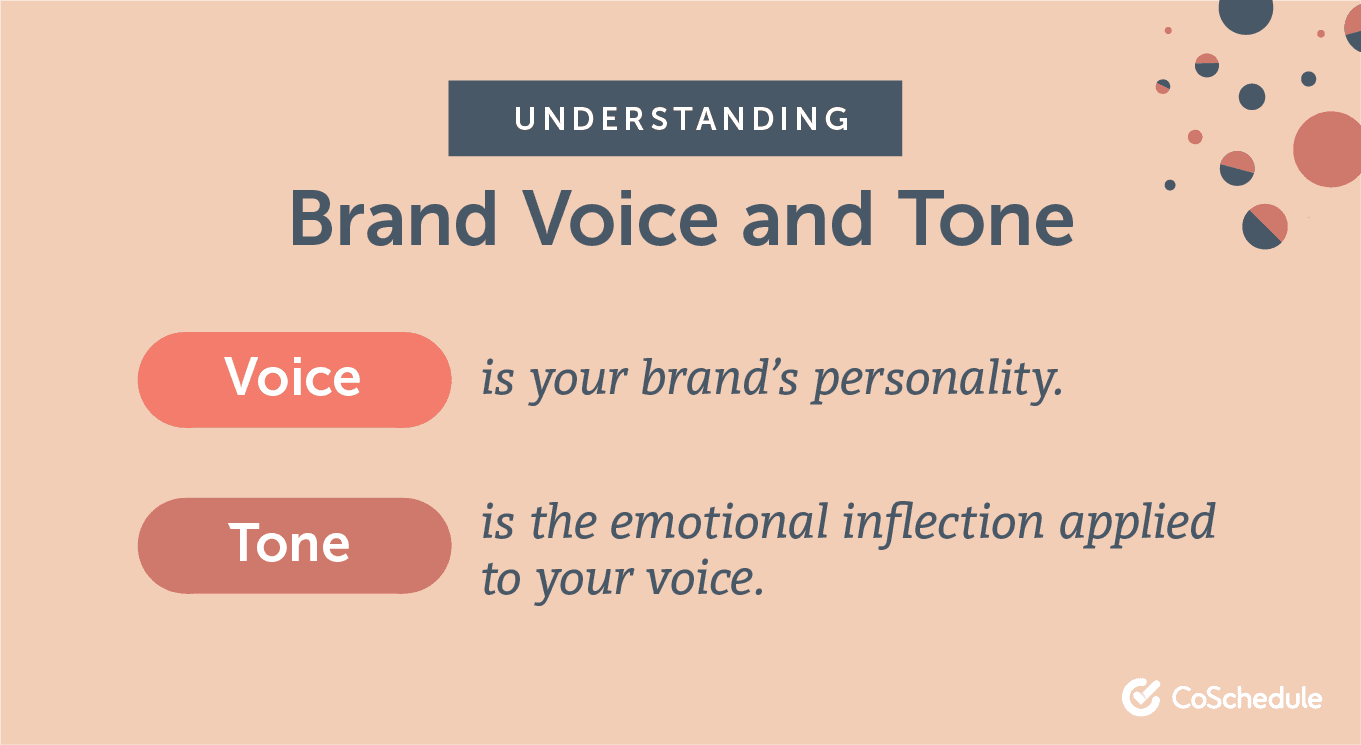
Formatting: Guidelines on formatting your content. As a minimum, define the following:
Header and subheader usage and capitalization
Use of bold and italicized text
Use of hyperlinks
Recommended paragraph length
Image guidelines: Types of images, captions, credit placement, and size.
Design elements: Color, typography, and logo usage.
Back to the Top
Step 4: Choose Content Channels
Channel selection is your next step. With most things in work and life, you’re better off choosing a few and being exceptionally great at them rather than choosing all and seeing mediocre or no results from them.
[Tweet “You’re better off choosing a few channels and being exceptionally great at them rather than choosing all and seeing mediocre or no results from them.”]
The two recommended channels for essentially any business are:
A website/blog, which is the major contributor to SEO efforts and success.
Email marketing, which drives upwards of 3,800% ROI.
These are your owned channels that shouldn’t be ignored. Beyond them, your channel selection, such as specific social media networks, entirely depends on your ideal customer.
Remember your target audience statement from the first step:
{Insert your company} creates content to attract {insert target audience}, so they can {insert desired outcome} better.
Based on this statement, list ideas of channels where your target audience typically searches for that desired outcome.
For example, if your target audience is looking for inspiration on home renovation and decoration, a YouTube channel, image-based blog posts with written instructions, and the visual nature of Instagram will probably give you the best chance of serving them.
Choose a small number of networks you can master and show up regularly.
Back to the Top
Step 5: Set a Publishing Cadence
Consider these two scenarios:
You publish three blog posts per week for a couple of weeks. Then, you get busy and don’t publish for months.
You publish two to three blog posts per month. You do so every month.
In the first scenario, you end up with less than ten blog posts in half a year, with no consistency or setting expectations of your audience. These posts were rushed, so they lack depth and detail.
In the second scenario, you end up with almost 20 blog posts. You took your time with them, so they’re detailed, comprehensive, and actionable.
In other words, consistency in both the quality and the cadence of your publishing pays off. With that in mind, list all your channels and define a publishing cadence from it. Here are some suggestions:
Blog post: twice per month (work towards four times per month)
Email: once per week
YouTube video: two to four times per month
Webinar: once or twice per month
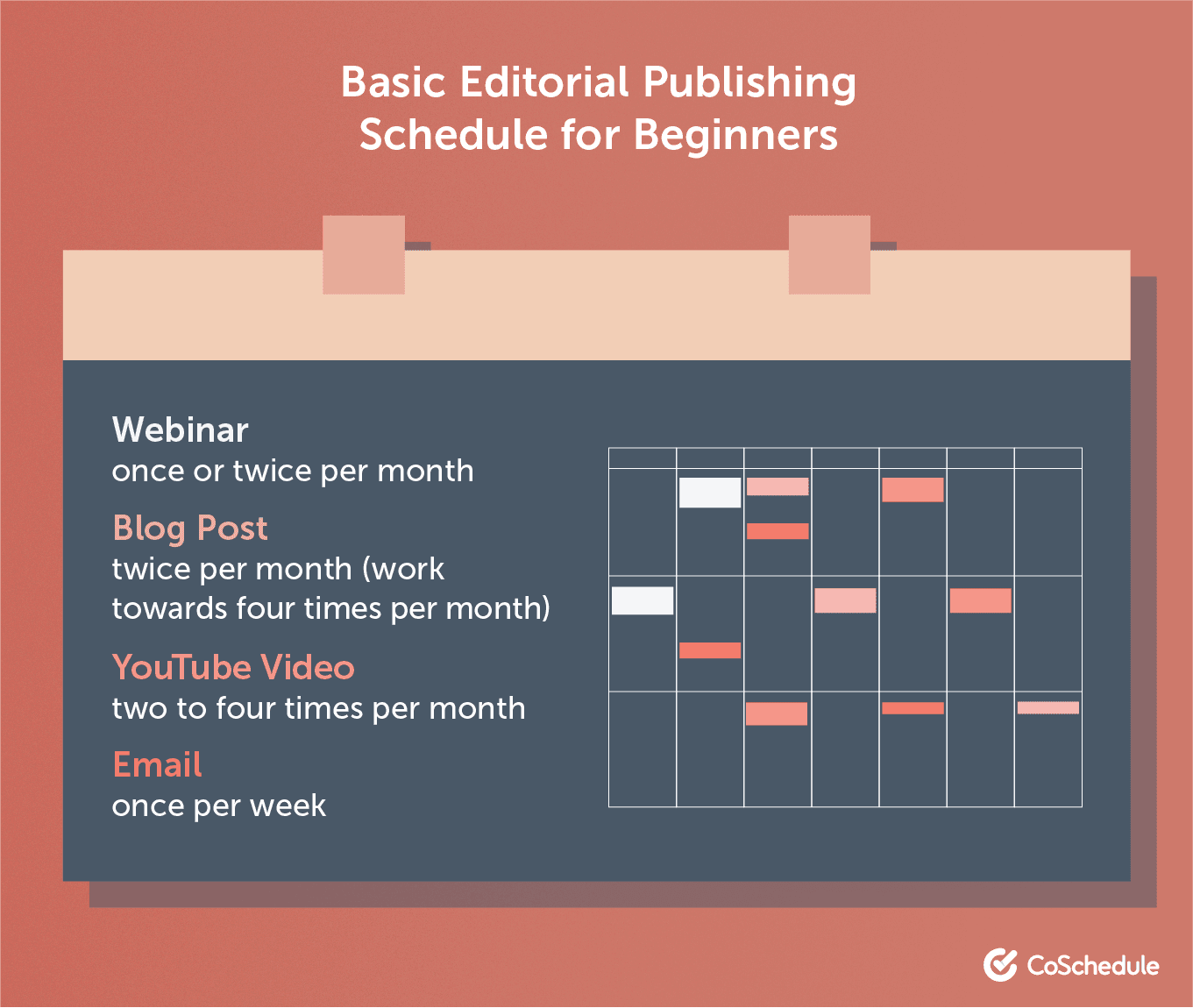
Here are some social media cadence suggestions (based on data from 14 studies):
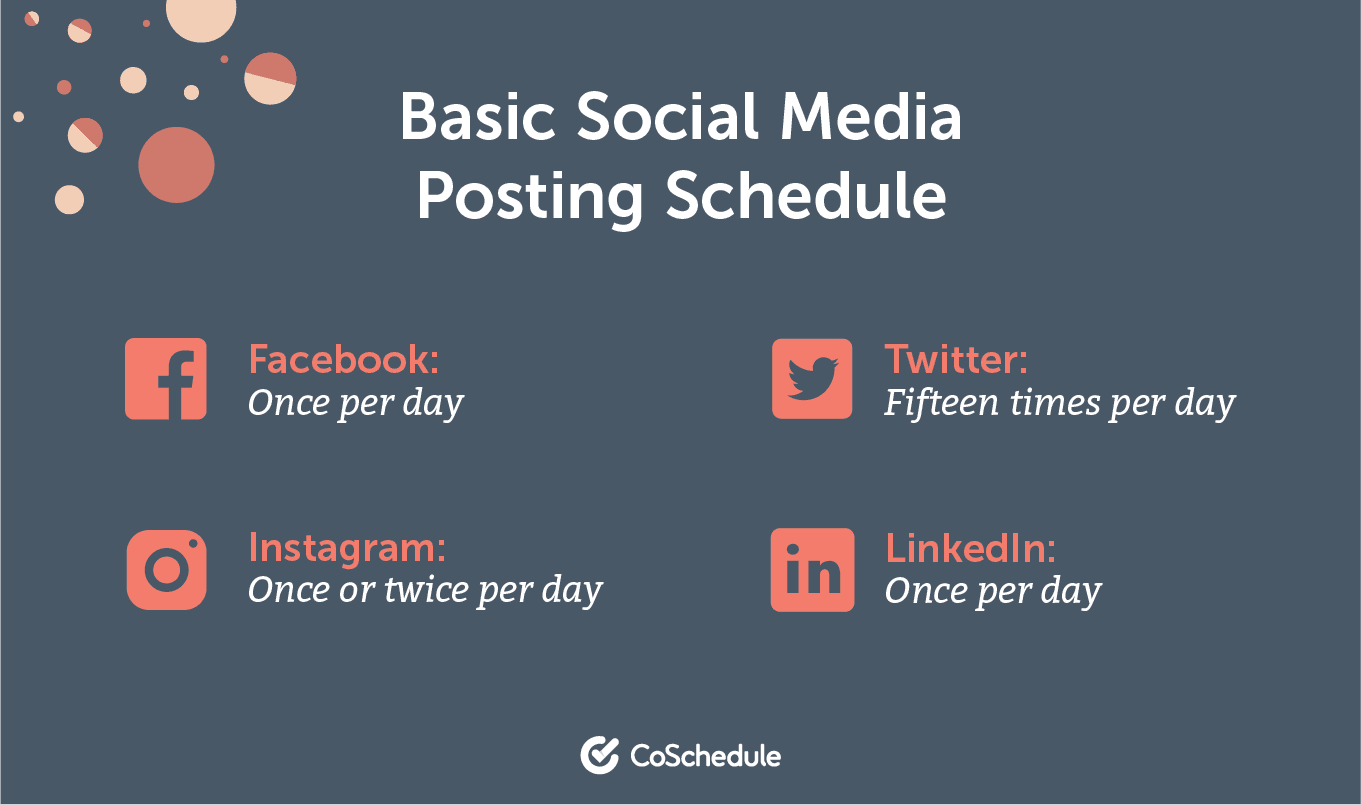
Find a realistic cadence you can consistently maintain, and remember you can always update it later. The next step will help you make it happen.
Back to the Top
Step 6: Develop Workflows For Each Type of Content
Once you have your content channels and a publishing cadence for each, you may want to jump straight into an editorial calendar.
Beware of this, as it’s a recipe for a potential disaster. Why? Because it only shows you when a piece of content is supposed to go live and not the tasks you need to complete to make it happen.
Content marketing workflows are the ideal solution to this. They turn a single entry on your big-picture editorial calendar — the publish date — into tangible tasks on calendars of team members responsible for them.
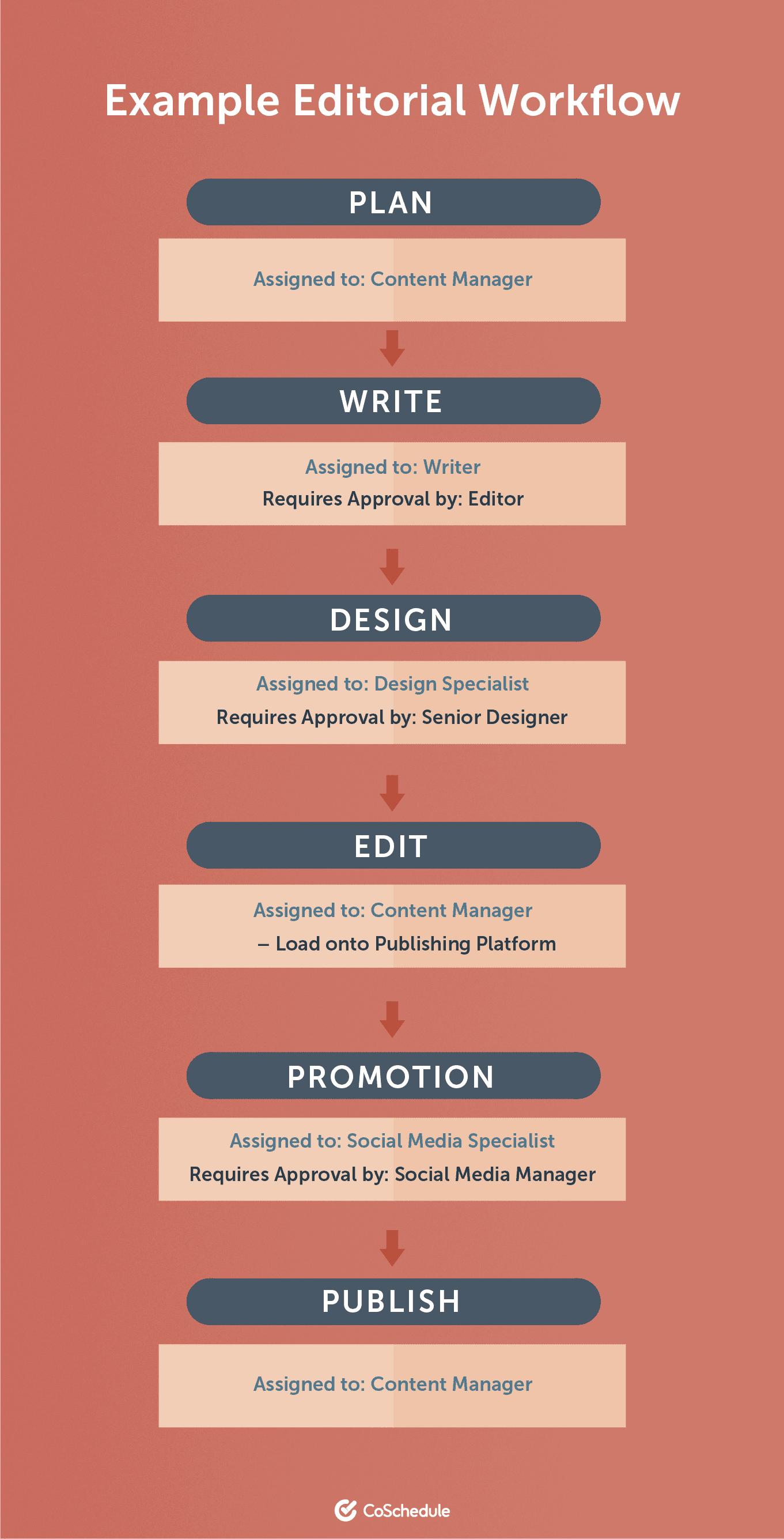
Create workflows for each of your content types by following these steps:
List every step of the creation process. What needs to get done and in what order?
Add the responsible role for each of those tasks. Who will make sure the task is completed?
Define when each task needs to happen. How long does it take? When does it need to happen for the project to stay on track?
Identify any dependencies. Does one task rely on the completion of another one (e.g. design may depend on editing)? Does it need someone’s approval?
For example, here’s what a workflow may look like for a blog post:
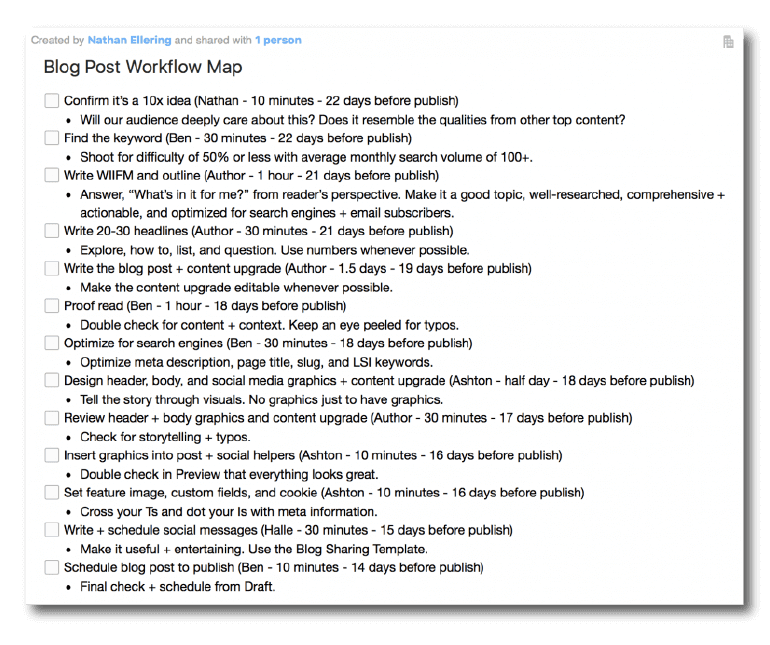
If you use a tool like CoSchedule, these items can exist as tasks on a relevant team member’s to-do list. They’ll get notified about it, so that nothing ever slips through the cracks.
To save time going forward, you can use Task Templates to create reusable checklists for your workflows. Then, you can add them to each new planned piece of content in just a few clicks.
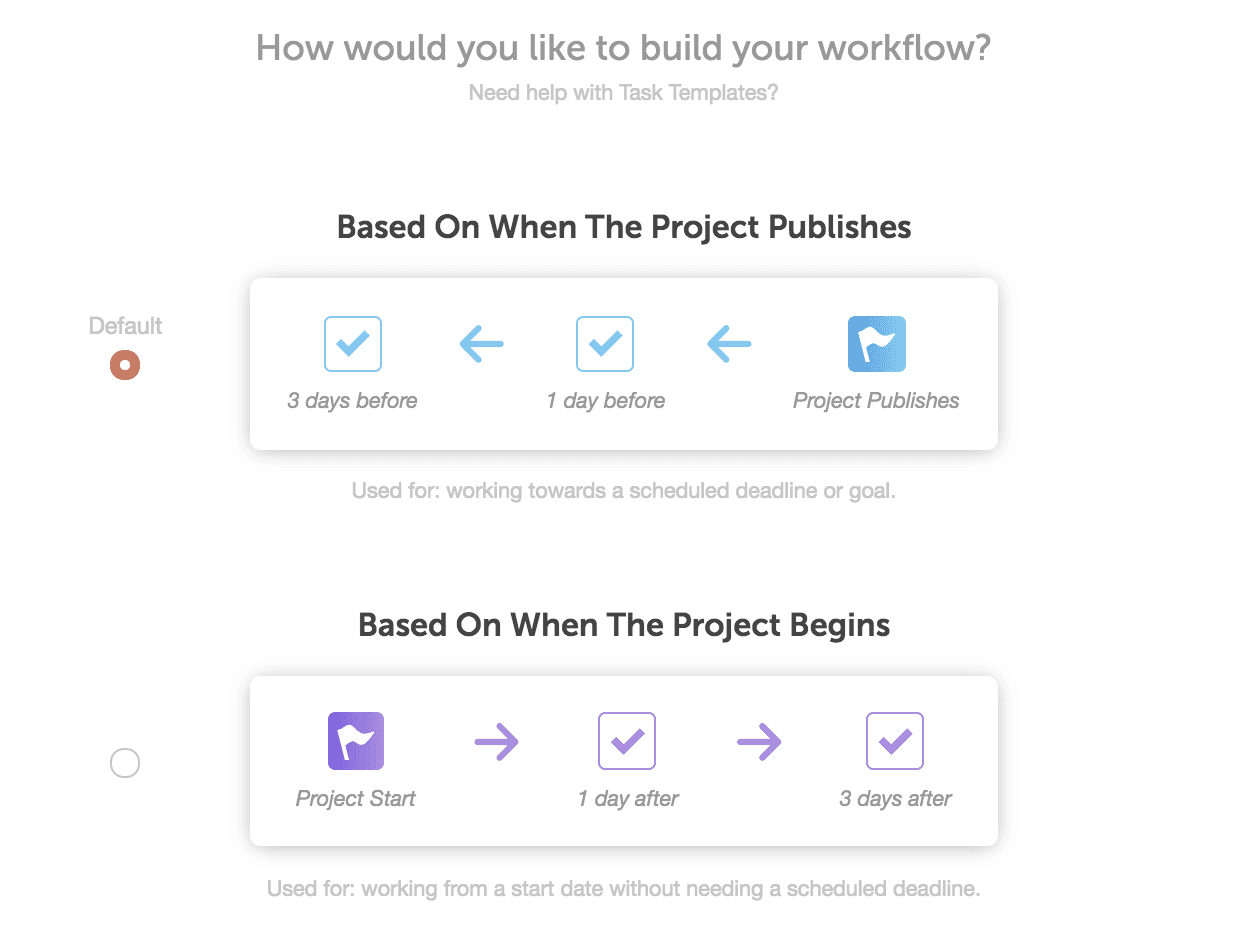
Because the dates on your workflows are relative to either the publish date or project start date, all tasks will automatically get an assigned date, which will help you plan with more precision and get everything done on time.
Back to the Top
Step 7: Visualize Your Publishing Schedule On an Editorial Calendar
The final step to an effective editorial strategy is the editorial calendar. While an editorial calendar is not a strategy in and of itself, it will help you visualize and organize the execution of it.
Recommended Reading: Facebook Marketing Strategy: How to Plan the Best One in 8 Steps
A content marketing editorial calendar gives you a bird’s-eye view of what’s going on at all times. In an ideal world, it won’t just show you your marketing campaigns, but how they relate to product launches and other key events for your company, too.
This makes it easy to move marketing projects around when things change. Many times, they inevitably do.
Your editorial calendar should enable you to:
Centralize all your marketing activity from your emails, notebooks, Post-Its, and numerous spreadsheets into a single place.
Quickly gauge each team member’s workload and reassign tasks if necessary.
Share your progress with your boss, other teams, etc.

Ever thought about how wonderful it would be to take control of all your marketing processes? Your editorial calendar is how you’ll make it happen.
If you want to start with a simple spreadsheet, here’s what your calendar could look like:
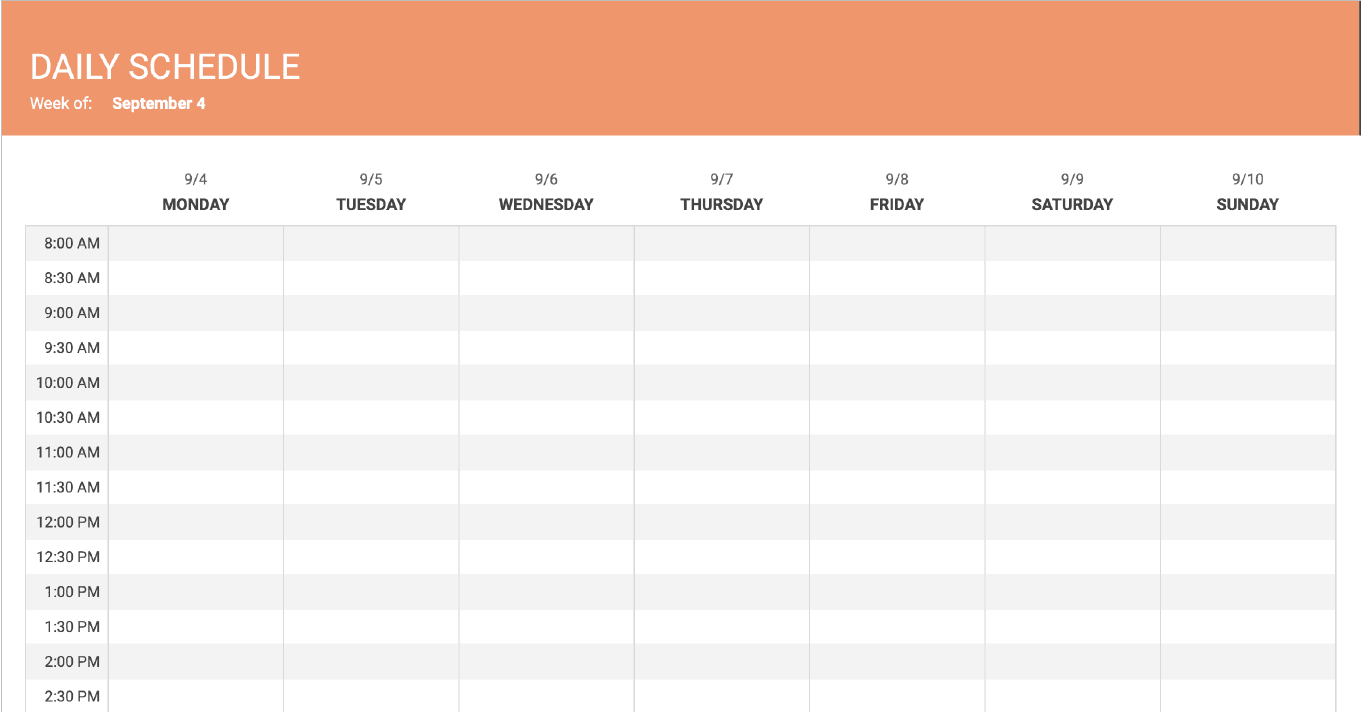
If you want a more flexible option with a drag-and-drop ability, CoSchedule’s Marketing Calendar helps you do exactly that. It looks like this:
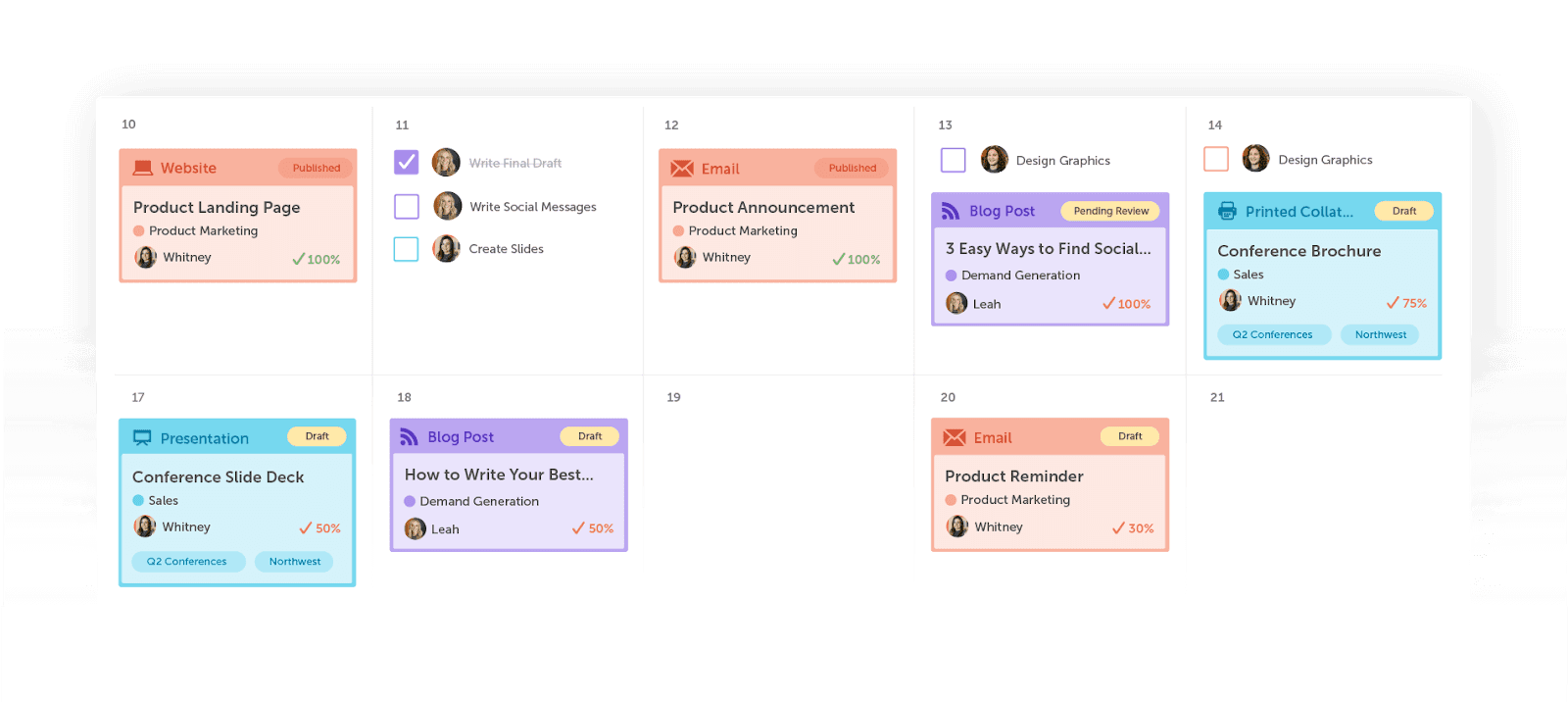
This calendar goes a lot deeper than a simple visual overview of your marketing projects. You can use Discussion Threads to collaborate with your team members, get their feedback, share attachments, and more.
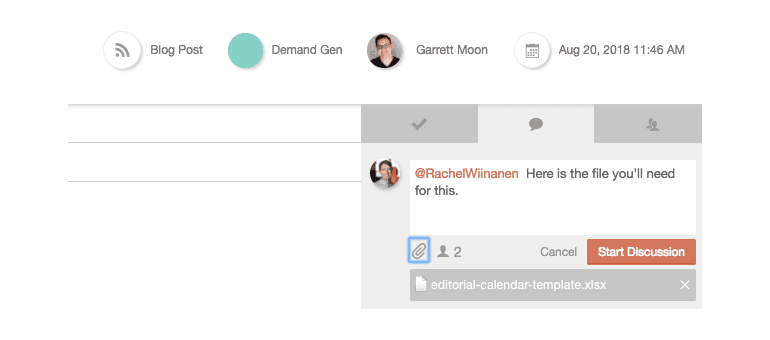
Finally, you can publish directly from your calendar, too, thanks to WordPress, social media, and email marketing integrations.
Back to the Top
Create Your High-performing Editorial Strategy
An editorial strategy isn’t a quick fix. It’s a complete way of knowing where you need to show up with which type of content to hit your marketing goals for months and years to come.
[Tweet “An editorial strategy isn’t a quick fix. It’s a complete way of knowing how to hit your marketing goals.”]
Don’t get overwhelmed with all possible options. Start simple and focus on an editorial strategy that will create results both for your business and your target audience. Use this strategy to turn great ideas into tangible actions on your calendar and start executing them.
Recommended Reading: How to Craft a Small Business Content Marketing Strategy in 7 Steps
The post How to Develop an Editorial Strategy That Gets Results (Template) appeared first on CoSchedule Blog.
Read more: coschedule.com
